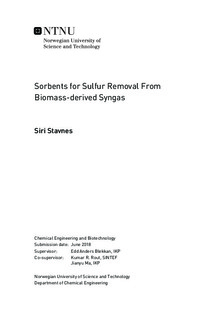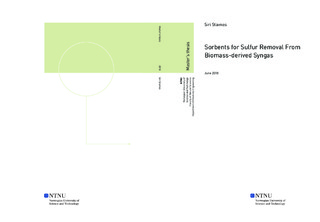| dc.description.abstract | The rising concern of global warming and emission of greenhouse gases have increased the demand for sustainable resources. Biomass is carbon neutral and a renewable energy source, thus a promising alternative to produce biofuels for the replacement of fossil fuels. Biomass gasification is one possible pathway for biofuel production. However, a drawback of this process is the produced syngas which contains undesirable contaminants. Sulfur species are most detrimental and can cause severe damages on downstream equipment. Moreover, sulfur species are a known catalyst poison and have a negative impact on the environment. Thus, it is strongly desirable to remove these contaminants from the process. High-temperature gas cleaning using solid
sorbents is a energy efficient and low-cost method for removal of sulfur, and several materials have been studied for this purpose. Manganese possesses great advantages such as high thermal stability and sorption capacity, thus a promising alternative. The main objective of this paper was to optimize alumina (Al2O3)-supported manganese oxide (MnOx ) sorbents for high-temperature sulfur removal by zirconium oxide (ZrO2) modification.
A series of regenerable Zr-promoted Mn/Al2O3 sorbents were prepared by incipient wetness impregnation using Zr- and Mn-nitrate precursor. Sorbents were calcined in air at 500 celsius and 700 celsius, and Zr-loading varied from 0, 1, 5 and 10wt%. In addition, a selection of sorbents were prepared by co-precipitation (0, 1 and 10wt% Zr). Desulfurization performance of the prepared sorbents were tested in a quartz fixed bed reactor over ten (10) sorption and regeneration cycles. Moreover, the effect of Zr-loading, calcination temperature and preparation method on sorbent capacity and stability was investigated. N2-adsorption, X-ray diffraction (XRD), temperature programmed reduction (TPR), X-ray fluorescence (XRF) and scanning electron microscopy (SEM)
were applied to characterize the fresh and reacted sorbents.
The overall result indicates that the Zr1-Mn/Al2O3 (1wt% Zr and 15wt% Mn) sorbent prepared by incipient wetness impregnation and calcined at 700 celsius is a promising candidate for removal of H2S. This sorbent showed the best desulfurization performance, and higher calcination temperature is beneficial as less deactivation is observed. Although sorbents prepared by co-precipitation have a higher initial capacity, the deactivation is larger after multiple sorption and regeneration cycles. | |

